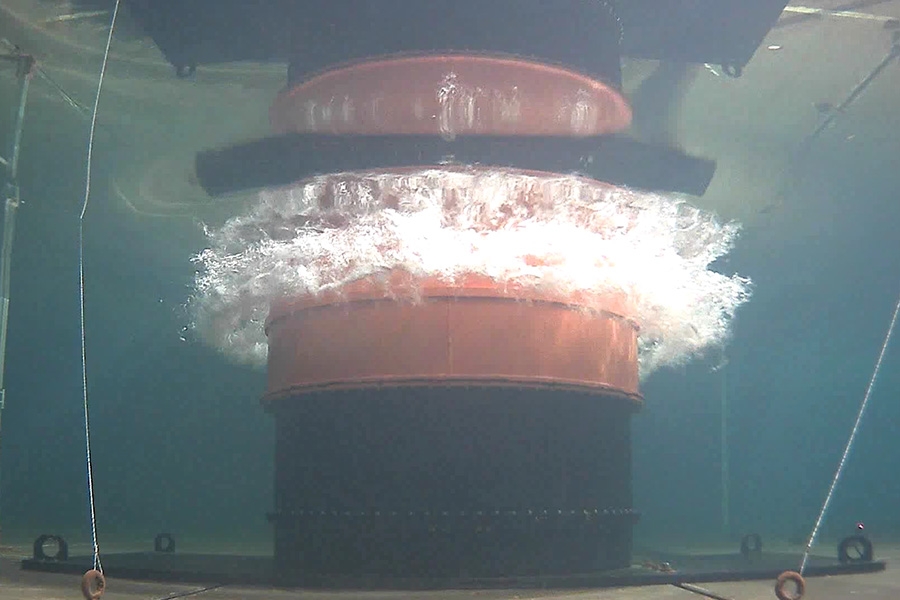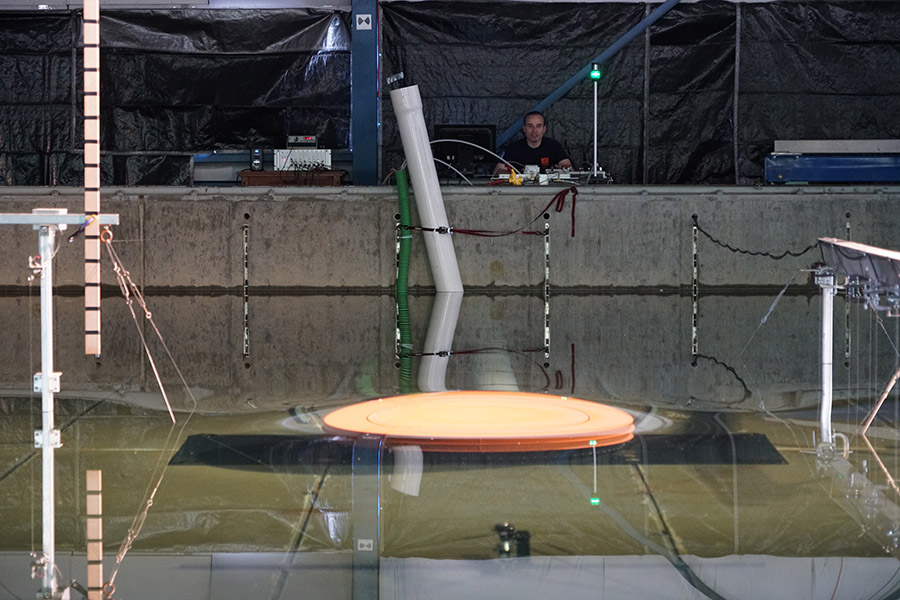
 The water surface bows upward as Professor Hermann Fritz, background, launches the volcanic tsunami generator from the control stand in the Hinsdale wave basin at Oregon State University. Fritz and collaborators at the University of Oregon and Texas A&M University at Galveston are using the data from these experiments to understand how underwater volcanoes generate tsunami waves and improve predictive models. (Photo: Angela Del Rosario) The water surface bows upward as Professor Hermann Fritz, background, launches the volcanic tsunami generator from the control stand in the Hinsdale wave basin at Oregon State University. Fritz and collaborators at the University of Oregon and Texas A&M University at Galveston are using the data from these experiments to understand how underwater volcanoes generate tsunami waves and improve predictive models. (Photo: Angela Del Rosario)
|
Last summer, Hermann Fritz was watching a miniature volcano erupt over and over again.
The idea was to generate tsunamis from the eruption or a resulting landslide to see how these rare events differ from their more common earthquake-generated cousins.
It was timely work: just a few months later, in December 2018, a volcano in Indonesia erupted and collapsed; the resulting tsunami killed hundreds.
Through their experiments, Fritz and his colleagues hope to understand how tsunami waves propagate from such an eruption. Perhaps more importantly, they also want to refine and validate prediction models to help give better warnings to people in harm’s way.
 This series of photos shows the volcanic tsunami generator simulating a volcanic eruption by “punching” through the water’s surface. Professor Hermann Fritz built this one-of-a-kind setup and conducted a series of experiments to better understand tsunamis created by eruptions of underwater volcanoes. (Photos: Yibin Liu) |
On December 22, 2018, the Indonesian island-volcano Anak Krakatau erupted, including a violent submarine eruption from its main conduit. More than two-thirds of the volcano collapsed into the sea, resulting in a tsunami that killed more than 400 and injured more than 14,000.
Today, researchers lack critically important data about tsunamis generated by underwater volcanoes. Although relatively rare, submarine volcanic eruptions lead to large and sudden displacement of water or slope failure — which cause tsunamis.
Hermann Fritz, professor at the Georgia Tech School of Civil and Environmental Engineering, aims to provide this missing data. And he is doing it by designing his own tsunami generation machine and creating his own tsunamis in Oregon State University’s Hinsdale wave basin laboratory, an NSF-funded NHERI experimental facility.
Fritz’s NSF-funded work is particularly appealing in light of several recent volcano-related tsunamis in the Ring of Fire region, including Anak Krakatau. “The processes in that eruption are not exactly the same as the scenarios we created,” says Fritz. But there are parallels, he says.
“Ours is a unique application because we did not use the wave basin traditionally,” Fritz says. “We basically installed a tsunami wave generator on the basin floor.”
Working with an engineering firm to fabricate the device, Fritz and his team designed an underwater volcano that could send a vertical column of water up through the water’s surface to cause a big displacement — so he and his team could record and study the processes of submarine-generated tsunamis.
In over 300 experiments with his custom-built volcanic tsunami generator, Fritz and his graduate student Yibin Liu simulated different types of volcanoes, and they measured 3D velocities and surface elevation around the volcano — as well as runup on the shoreline.
Read the full story in the Natural Hazards Engineering Research Infrastructure newsletter.
Related
